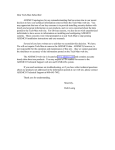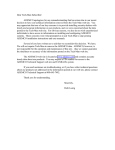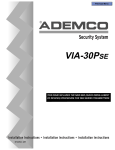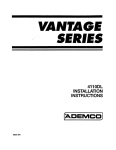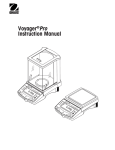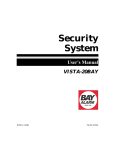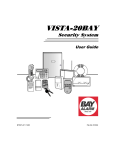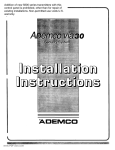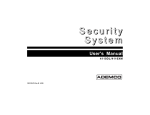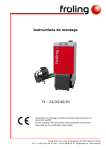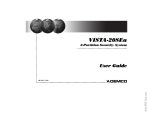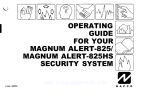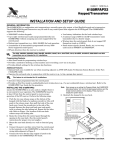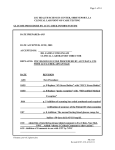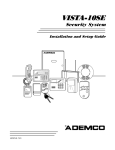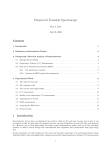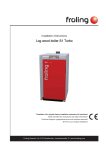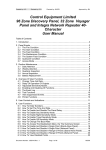Download 4110DL Installation Manual
Transcript
SECURITY SYSTEM
4110DL
TANT
R
O
P
OR IM A TION!!
F
R
E
COV
FORM
E
N
D
I
I
S
D
N
SEE I ATURES AN
FE
NEW
• Installation Instructions
N5672V3 10/96
Please Read
INFORMATION CONCERNING NEW FEATURES
Controls with microprocessor part number N7185V3 or higher contain the following new features. These controls
can be identified via the downloader as Rev. 06.
1.
This control complies with National Fire Protection Association (NFPA) requirements for temporal pulse sounding of fire notification
appliances. Fire alarms now sound as interrupted pulses consisting of three pulses and a brief pause (i.e. ring, ring, ring, pause ring, ring, ring, pause, etc.)
2.
Capability has been added for the control to call a pager on the secondary telephone number. This can only be used if the primary
reporting format is Ademco Contact ID. The following entries have been added to program field *49 (Split/Dual Reporting) for the
purpose of paging messages:
Primary
Secondary (Paging number)
6 = All reports except Open/Close
7 = All reports
8 = All reports
Alarms/ Open/Close, Troubles
Alarms, Troubles
Alarms, Open/Close, Troubles
Touch-tone codes sent to the pager are:
1911 = Alarm
1001 = Open
1002 = Close
1811 = Trouble
No restore reports are sent to the pager.
3.
Three additional user codes have been added (identified as Users 5, 6, and 7).
4.
Duress is now User 8 (no longer User code + 1).
5.
AC Loss report is now sent at a random time delay up to 1 hour. If AC is restored before the report goes out, no report will be sent.
6.
Telephone number entries can now contain *, #, and a 2-second pause.
Enter # + 11 for "*"
Enter # + 12 for "#"
Enter # + 13 for 2-sec. pause
7.
Audible Exit Warning option has been added (field *27: 0 = no; 1 = yes [default = 1]). If enabled, beeping will occur during exit time
and will change from slow to rapid beeping during last 5 seconds of exit delay.
8.
Master code is now able to change itself in normal operating mode. To change, enter:
[Master code] + [8] + [1] + [new Master code] + [new Master code] again.
9.
New Telco Hand-off feature allows the technician at the site to call the downloading facility from the control panel phone line,
initiate a site download (Master Code + # +1), and the control will immediately be on-line with the modem at the downloading
facility.
10.
If all power is lost at the control, upon power up, the armed status will be the same as it was before the power loss. Bypasses,
however, are not retained.
11.
The control checks for the physical battery connection every two minutes. If connection is lost, a visual and audible trouble is
indicated, and a communicator report will be sent (if programmed). The actual condition of the battery is still checked once every
four hours. To clear the low battery message after the low battery condition is restored, enter Test mode: [User code] + [5];
otherwise it will clear itself the next time the system checks the battery's condition.
TABLE OF CONTENTS
RECOMMENDATIONS FOR PROPER PROTECTION ............................. 5
Section 1. GENERAL DESCRIPTION......................................................................... 6
FEATURES .......................................................................................... 6
SPECIFICATIONS ............................................................................... 6
COMPATIBLE DEVICES ................................................................ ..... 6
ZONE RESPONSE TYPE CHARACTERISTICS ................................. 7
WIRING GUIDELINES ......................................................................... 7
Section 2. SYSTEM INSTALLATION AND WIRING .................................................. 8
Section 3. PROGRAMMING THE SYSTEM................................................................ 9
THE MECHANICS OF PROGRAMMING ............................................ 9
Entering Program Mode................................................................. 9
Programming a Data Field ............................................................. 9
Reviewing a Data Field .................................................................. 9
Erasing an Entry in a Data Field .................................................... 9
Downloading .................................................................................. 9
Clearing All Data Fields ................................................................. 9
Exiting Program Mode ................................................................... 9
Section 4. SYSTEM OPERATION............................................................................... 10
USER ACCESS CODES...................................................................... 10
Adding a Secondary User Code .................................................... 10
Deleting a Secondary User Code .................................................. 10
KEYPAD FUNCTIONS......................................................................... 10
System Commands ....................................................................... 10
Panic Keys..................................................................................... 10
Keyswitch LED Indications ............................................................ 10
Keyswitch Operation ...................................................................... 10
Section 5. TESTING THE SYSTEM ............................................................................ 11
REGULATORY AGENCY STATEMENTS................................................. 12
DOC STATEMENT..................................................................................... 13
THE LIMITATIONS OF THIS ALARM SYSTEM ....................................... 14
SUMMARY OF CONNECTIONS DIAGRAM ............ INSIDE BACK COVER
ADEMCO LIMITED WARRANTY .......................................... BACK COVER
–4–
RECOMMENDATIONS FOR PROPER PROTECTION
The Following Recommendations For The Location Of Fire And
Burglary Detection Devices Help Provide Proper Coverage For
The Protected Premises.
Recommendations For Smoke And Heat Detectors
With regard to the number and placement of smoke/heat detectors, we subscribe to the
recommendations contained in the National Fire Protection Association's (NFPA) Standard #72
noted below.
Early warning fire detection is best achieved by the installation of fire detection equipment
in all rooms and areas of the household as follows: For minimum protection a smoke detector
should be installed outside of each separate sleeping area, and on each additional floor of a
multi-floor family living unit, including basements. The installation of smoke detectors in
kitchens, attics (finished or unfinished), or in garages is not normally recommended.
For additional protection the NFPA recommends that you install heat or smoke detectors in
the living room, dining room, bedroom(s), kitchen, hallway(s), attic, furnace room, utility and
storage rooms, basements and attached garages.
In addition, we recommend the following:
• Install a smoke detector inside every bedroom where a smoker sleeps.
• Install a smoke detector inside every bedroom where someone sleeps with the door partly
or completely closed. Smoke could be blocked by the closed door. Also, an alarm in the
hallway outside may not wake up the sleeper if the door is closed.
• Install a smoke detector inside bedrooms where electrical appliances (such as portable
heaters, air conditioners or humidifiers) are used.
• Install a smoke detector at both ends of a hallway if the hallway is more than 40 feet (12
meters) long.
• Install smoke detectors in any room where an alarm control is located, or in any room
where alarm control connections to an AC source or phone lines are made. If detectors are
not so located, a fire within the room could prevent the control from reporting a fire or an
intrusion.
✪
KITCHEN
▲
DINING
✪
✪
✪
BEDROOM BEDROOM
TV ROOM
■
✪
✪
LIVING ROOM
BEDROOM
▲
KITCHEN
✪
DINING
■
LIVING ROOM
✪
■
✪
BDRM
BDRM
✪
BEDROOM
✪
▲
■ Smoke Detectors for Minimum Protection
✪ Smoke Detectors for Additional Protection
▲ Heat-Activated Detectors
■
BEDROOM
✪
■
✪
BEDROOM
TO
BR
BEDROOM
■
▲
▲
KTCHN
.
LVNG RM
■
CLOSED
DOOR
GARAGE
BASEMENT
Recommendations For Proper Intrusion Protection
For proper intrusion coverage, sensors should be located at every possible point of entry to a home or
commercial premises. This would include any skylights that may be present, and the upper windows
in a multi-level building.
In addition, we recommend that radio backup be used in a security system so that alarm signals can
still be sent to the alarm monitoring station in the event that the telephone lines are out of order
(alarm signals are normally sent over the phone lines, if connected to an alarm monitoring station).
–5–
Section 1. GENERAL DESCRIPTION
The 4110DL is a microprocessor-based state-of-the-art security controls intended for wired applications. The
Control Panel supports up to 6 hardwired zones and can be programmed either through the keypad or
remotely using ADEMCO's V-LINK downloading software.
––––––––––––––––––––––––––––––––––– FEATURES ––––––––––––––––––––––––––––––––––––
Zones Supported
•
6 hardwire zones,
characteristics:
having
the
Alarm Output
following
Provides a 12VDC, 2 AMP output (assumes a fully
charged battery is connected)
◊
EOLR supervision supporting N.O. or N.C.
sensors.
•
Steady output for Burglary/Panic, or pulsing
output for Fire
◊
300-500 msec normal response.
•
Output is current limited
◊
Zone 3 programmable for Fast Response to
open (10mS).
Communication Formats
•
Security Codes
•
1 master code for entire system (user 1)
•
3 secondary user codes (users 2-4)
•
•
Ademco Low Speed (Standard or Expanded):
1400Hz ACK/KISSOFF.
Sescoa/Radionics (Standard or Expanded):
2300Hz ACK/KISSOFF.
Ademco Express :
DTMF, 1400/2300Hz ACK, 1400Hz KISSOFF.
Keypad Panic Keys
•
•
•
Provides 3 panic key functions
Ademco Contact ID:
DTMF 1400/2300Hz ACK, 1400Hz KISSOFF.
–––––––––––––––––––––––––––––––– SPECIFICATIONS ––––––––––––––––––––––––––––––––
4110DL CONTROL
1.
2.
UL
Physical:
12-1/2" W x 14-1/2" H x 3" D (318mm x 368mm x
76mm)
Electrical:
VOLTAGE INPUT: 16.5VAC from plug-in 25VA
transformer, Ademco No. 1321/TF2 (in U.S.A.),
1321CN (in Canada)
RECHARGEABLE BACK-UP BATTERY: 12VDC,
4AH (Gel type).
CHARGING VOLTAGE : 13.8VDC.
ALARM SOUNDER: 12V, 2.0 Amp output
AUXILIARY POWER OUTPUT : 12VDC, 500mA
max. Interrupts for 4-wire smoke detector reset.
MAXIMUM ZONE RESISTANCE: Zones 1-8 =
300 ohms excluding EOLR
In UL installations, maximum current
draw from the Auxiliary Output and
the Alarm Output combined must not
exceed 500mA total.
FUSE :
Battery (3A) No. 90-12
LINE SEIZE: Double Pole
REGULATORY INFORMATION
Ringer Equivalence: 0.7B
FCC Registration No.: AC 398U-68192-AL-E
UL File No. S1632, Guide UXOU
––––––––––––––––––––––––––––– COMPATIBLE DEVICES ––––––––––––––––––––––––––––
Remote Keypads (up to 4)
Model
4127, 6127
Type
Fixed English
4137AD, 6137, 6128
Fixed English Addressable
5330 (Select for Vista)
Alpha
IMPORTANT
Smoke Detectors (4-wire only)
Model
Type
1412
Ionization Products of Combustion
Detector
Photoelectric Smoke Detector
Photoelectric Smoke Detector)w/135º F
(57º C) Heat Detector)
2412
2412TH
Addressable keypads must be used in
the non-addressable mode (Device
Address 31), which is pre-set at the
factory. Do not set these keypads to
any other addresses.
Fire Supervisory Module
A77-71601 EOL Relay Module (supervises power for 4 wire fire zone).
Optional Keyswitch
4116 Keyswitch
-6-
––––––––––––––––– ZONE RESPONSE TYPE CHARACTERISTICS ––––––––––––––––––
Zone Response Type
Characteristics
1 – Entry/Exit Burglary
•
•
3 – Perimeter Burglary
4 – Interior, Follower
•
•
•
•
5 – Trouble by Day/Alarm by
Night
6 – 24-Hr. Silent Alarm
•
•
•
7 – 24 Hr. Audible Alarm
•
8 – 24-Hr. Auxiliary Alarm
•
9 – Fire
•
10 – Interior w/Delay
•
•
•
Provides exit delay time when panel is armed in any arming mode.
Provides entry delay when panel is armed in Away and Stay modes
only.
Provides an instant alarm when panel is armed in any arming mode.
Provides exit delay time when panel is armed in any mode.
Will only provide entry delay if an Entry/Exit zone is faulted first upon
entry. Otherwise, alarm will be instant.
Bypassed automatically when panel is armed in the Stay or Instant
mode.
Provides a trouble response if panel is not armed when zone is faulted.
Provides an instant alarm if panel is armed in any mode.
Provides a silent alarm to Central Station whether panel is armed or
disarmed.
Provides an audible alarm at the bell output and keypad whether
panel is armed or disarmed.
Provides an audible alarm at the keypad only. No bell output is
provided.
Provides a fire alarm when zone is shorted. Causes bell output to
pulse.
Provides a trouble response when zone is open.
Provides entry and exit delay times.
Bypassed automatically when panel is armed in the Stay or Instant
mode.
–––––––––––––––––––––––––––WIRING GUIDELINES ––––––––––––––––––––––––––––
Wiring Run Chart For Devices* Drawing Aux Power From
The Control (12V+ & GND)
TOTAL CURRENT DRAWN BY ALL DEVICES CONNECTED TO A SINGLE WIRE
RUN
Wire Size
50 mA or less
100 mA
300 mA
500 mA
#22
500 ft (152m)
250 ft (76m)
80 ft (24m)
50 ft (15m)
#20
750 ft (228.6m)
380 ft (116m)
130 ft (39.6m)
80 ft (24m)
#18
1300 ft (396m)
650 ft (198m)
220 ft (67m)
130 ft (39.6m)
#16
1500 ft (457m)
1000 ft (305m)
330 ft (100.5m)
200 ft (70m)
* Includes Keypads and alarm devices requiring separate power.
Example: If you have two motion detectors that draw a total of 44 mA, and you are using #20 AWG
wire, the distance from the control panel Aux + and - terminals to the last device can be up
to 750 ft.
IMPORTANT
The length of all wire runs for keypads must not exceed 1500 feet (457m)
when unshielded quad conductor cable is used (750 feet if shielded cable is
used). This restriction is due to the capacitive effect on the data lines when
quad cable is used.
Transformer Wiring Table
Distance of Transformer
From the Control Panel
Up to 50 feet
50–100 feet
100–250 feet
-7-
Wire Gauge
To Use
# 20
# 18
# 16
Section 2.
SYSTEM INSTALLATION AND WIRING
––––––––––––––––––––––––– INSTALLING THE SYSTEM –––––––––––––––––––––––
Refer to the Summary of Connections diagram on the inside back cover of this manual for terminal
connections when following these procedures.
1.
Mount the Control Cabinet.
2.
Mount the PC board.
WARNING
BE SURE TO USE THE PLASTIC MOUNTING CLIPS (SUPPLIED) TO
ISOLATE THE CIRCUIT BOARDS FROM THE CABINET. FAILURE
TO DO SO MAY RESULT IN DAMAGE TO THE TRANSFORMER
AND/OR THE CIRCUIT BOARDS.
3.
Install Remote Keypads.
4.
Install Hardwired Zones.
5.
Install Sounding Devices.
UL
Use only UL Listed sounding devices for UL installations.
6.
Install the Remote Keyswitch.
7.
Connect Telephone Line.
Make sure telephones on the premises are connected only through the
alarm control panel (disconnect from the incoming phone line at the
telephone jack). This is necessary to have true line seizure.
IMPORTANT
8.
Connect the AC Transformer.
DO NOT PLUG THE TRANSFORMER INTO THE AC OUTLET UNTIL
ALL OTHER WIRING TO THE CONTROL IS COMPLETE.
WARNING
9.
Connect the Battery.
IMPORTANT
UL
11.
Do not attach the connector cable to the battery's terminals until
after you have plugged the AC transformer into an uninterrupted
120VAC outlet.
1.
2.
In UL installations, maximum current draw from the Auxiliary
Output and the Alarm Output combined must not exceed 500mA.
Use a 3A battery or larger for UL installations.
Connect Earth Ground.
-8-
Section 3. PROGRAMMING THE SYSTEM
––––––––––––––––––– THE MECHANICS OF PROGRAMMING ––––––––––––––––
For actual program fields, refer to the programming form included at the center of this manual.
Entering Program Mode
Use one of the following methods:
• Press both the [*] and [#] keys at the same time within 50 seconds after power is appled to the Control.
or
• After power-up, enter the [Master Code] + 8 + 0 (default Master Code is 4110)
This method is disabled if you exit the program mode using *98 instead of *99. See "Exiting Program
Mode" later in this section.
Once you have entered program mode, data field *20 will be displayed (this is the first field in the system).
The system will now accept entries for field *20.
Programming a Data Field
↓ Field Number
20
Press [*] plus [Field No.] (e.g., *20), and then make the required entry. Note the following:
• The keypad beeps three times when the data field has been completely programmed
• The next Field No. is displayed. If you do not want to program this field, press [*] + the Field No. you
want to program.
• If the number of digits that you need to enter in a data field is less than the maximum digits available
(e.g., the phone number field), enter the desired data, then press [*] + the next Field No. to be
programmed.
• If you try to enter a non-existent field, the keypad will display EE or Entry Error. Simply re-enter [*]
plus a valid Field No.
Reviewing a Data Field
Press [#] plus [Field No. ]. Note the following:
•
Data will be displayed for that field number, entry by entry (a beep will be heard between entries and
three beeps after the last).
•
No changes will be accepted in this mode.
•
If you try to enter a non-existent field, the keypad will display EE or Entry Error. Simply re-enter [#]
plus a valid field number.
Erasing an Entry in a Data Field
Applies only to fields *40-*43, and *94.
Press [*] plus Field No. plus [*].
Downloading
*96 resets the Subscriber Account number and CSID in preparation for an initial download. If *97 was
entered previously, *96 must be entered last.
Clearing All Data Fields
*97 clears (zeros) all data fields. The Master Code will now be 0 0 0 0.
DO NOT PRESS *97 IF ANY PROGRAMMING HAS BEEN DONE
PREVIOUSLY; DATA ALREADY PROGRAMMED INTO THE SYSTEM WILL
BE DELETED.
WARNING
Exiting Program Mode
*98 inhibits re-entry into the programming mode with the use of the Master Code.
*99 allows re-entry into the program mode using Master Code + 8 + 0.
-8-
Section 4: SYSTEM OPERATION
–––––––––––––––––––––––––––– USER ACCESS CODES –––––––––––––––––––––––––––
Adding a Secondary User Code
MASTER CODE + [CODE KEY] + USER # ( 2, 3, OR 4) + DESIRED 4-DIGIT ACCESS CODE.
(The system will emit a single beep when a secondary code has been successfully entered.)
Deleting a Secondary User Code
MASTER CODE + [CODE KEY] + USER # (2, 3 OR 4)
Notes:
• All Master and Secondary security codes permit access to the system for arming, disarming, etc.
• If a secondary code is inadvertently repeated for different users, the lower user number will take
priority.
• Opening and closing reports are sent for the Master as No. 1. User codes are sent as
Numbers 2, 3,
and 4, respectively.
––––––––––––––––––––––––––– KEYPAD FUNCTIONS –––––––––––––––––––––––––––
System Commands
Before arming, the system must be in the READY condition (all zones must be intact). If the "NOT
READY" message appears, press the
READY [* ] key to display faulted zones.
SUMMARY OF SYSTEM COMMANDS
MODE
HOW TO PERFORM
AWAY
STAY
INSTANT
MAXIMUM
DISARM
BYPASS
Security Code + [2]
Security Code + [3]
Security Code + [7]
Security Code + [4]
Security Code + [1]
Security Code + [6] +
Zone #(s)
Security Code + [6]
QUICK BYPASS
(if enabled)
CHIME MODE
SITE-INITIATED
DOWNLOAD*
EXIT DELAY
ENTRYDELAY
Yes
Yes
Yes
Yes
Yes
Yes
No
No
PERIMETER
ARMED
Yes
Yes
Yes
Yes
INTERIOR ARMED
Yes
No
No
Yes
Security Code + [9]
(toggles on and off)
Security Code + [#] + [1]
* Initiates phone call to the downloading facility.
Panic Keys
A panic function is activated when:
• Both keys of the appropriate key pair are pressed at the same time, or
• The appropriate lettered key is pressed for at least 2 seconds.
The panic functions are identified by the system as follows:
Keys
Displayed as Zone
Zone Type
[1] & [*], or [A]
95
24-Hr. Silent
[ *] & [#], or [B]
7
Programmable (24-Hr.
Silent, Audible,
Auxiliary, or Fire
[3] & [#], or [C]
96
24-Hr. Audible
Keyswitch LED Indications
RED
MEANING
OFF
DISARMED & NOT READY
SLOW FLASH
ARMED READY
RAPID FLASH
ARMED
Notes:
•Keys [A], [B], [C] are not on all keypads.
•Key [D], if present, is not active here.
Keyswitch Operation
• To arm AWAY, turn key and release within a 1/2 second.
• To arm STAY, turn and hold key for longer than 2 seconds.
• To disarm, turn key and immediately release.
-10-
Section 5. TESTING THE SYSTEM
After installation is completed, the Security System should be carefully tested, as follows:
Test Mode
1. With the system in the disarmed state, check that all zones are intact. If a NOT READY
message is displayed, press the [ ✱] key to display the faulted zone(s). Restore faulted zone(s)
if necessary.
2. Enter the [Security Code] + [5] TEST. The following will occur:
• The outside sounder will sound for 1 second.
• A test report will be transmitted (if programmed) to the Central Station immediately. (If
the backup battery is discharged or missing, the sounder may not turn on and a LOW
BATTERY report will be transmitted with a TEST report.)
3. Fault and restore each zone.
• The keypad will emit 3 beeps each time a contact is faulted.
• The keypad will beep once per minute as a reminder that the system is in the Test Mode.
4.
Exit this mode by entering the [Security Code] + [1] OFF .
Armed System Test
Alarm messages will be sent to the central station during the following tests. Notify them in
advance that tests will be in progress.
1.
Arm the system and fault one or more zones.
2.
After 15 seconds (if optional dialer delay is selected), silence alarm sounder(s) by entering the
[Security Code] + [1] OFF. Check Entry/Exit delay zones.
3.
Check the keypad-panic alarms that are in the system by pressing the Panic key (key pairs
on some keypads).
• If the system has been programmed for audible emergency, the keypad will emit a steady
alarm sound, and ALARM and [Zone Number] will be displayed. Silence the alarm by
entering the [Security Code] and pressing OFF.
• If the system has been programmed for silent emergency, there will be no audible alarms
or displays, but a report will be sent to the central station.
4.
Notify the central station when all tests are finshed, and verify results with them.
TO THE INSTALLER
Regular maintenance and inspection (at least annually) by the master and frequent testing by the
user are vital to continuous satisfactory operation of any alarm system.
The master should assume the responsibility of developing and offering a regular maintenance
program to the user as well as acquainting the user with the proper operation and limitations of the
alarm system and its component parts. Recommendations must be included for a specific program of
frequent testing (at least weekly) to insure the system's proper operation at all times.
-11-
REGULATORY AGENCY STATEMENTS
UL NOTICE: This is a "Grade A" residential system.
FEDERAL COMMUNICATIONS COMMISSION (FCC) Part 15 STATEMENT
This equipment has been tested to FCC requirements and has been found acceptable for use. The FCC requires the
following statement for your information:
This equipment generates and uses radio frequency energy and if not installed and used properly, that is, in strict
accordance with the manufacturer's instructions, may cause interference to radio and television reception. It has been
type tested and found to comply with the limits for a Class B computing device in accordance with the specifications in
Part 15 of FCC Rules, which are designed to provide reasonable protection against such interference in a residential
installation. However, there is no guarantee that interference will not occur in a particular installation. If this
equipment does cause interference to radio or television reception, which can be determined by turning the equipment
off and on, the user is encouraged to try to correct the interference by one or more of the following measures:
• If using an indoor antenna, have a quality outdoor antenna installed.
• Reorient the receiving antenna until interference is reduced or eliminated.
• Move the radio or television receiver away from the receiver/control.
• Move the antenna leads away from any wire runs to the receiver/control.
• Plug the receiver/control into a different outlet so that it and the radio or television receiver are on different branch
circuits.
If necessary, the user should consult the dealer or an experienced radio/television technician for additional
suggestions. The user or master may find the following booklet prepared by the Federal Communications Commission
helpful:
"Interference Handbook"
This booklet is available from the U.S. Government Printing Office, Washington, DC 20402.
The user shall not make any changes or modifications to the equipment unless authorized by the Installation
Instructions or User's Manual. Unauthorized changes or modifications could void the user's authority to operate the
equipment.
FEDERAL COMMUNICATIONS COMMISSION (FCC) Part 68 STATEMENT
This equipment complies with Part 68 of the FCC rules. On the front cover of this equipment is a label that contains,
among other information, the FCC registration number and ringer equivalence number (REN) for this equipment. If
requested, this in formation must be provided to the telephone company.
This equipment uses the following jacks: An RJ31X is used to connect this equipment to the telephone network.
The REN is used to determine the quantity of devices which may be connected to the telephone line. Excessive RENs
on the telephone line may result in the devices not ringing in response to an incoming call. In most, but not all areas,
the sum of the RENs should not exceed five (5.0). To be certain of the number of devices that may be connected to the
line, as determined by the total RENs, contact the telephone company to determine the maximum REN for the calling
area.
If this equipment causes harm to the telephone network, the telephone company will notify you in advance that
temporary discontinuance of service may be required. If advance notice is not practical, the telephone company will
notify the customer as soon as possible. Also, you will be advised of your right to file a complaint with the FCC if you
believe necessary.
The telephone company may make changes in its facilities, equipment, operations, or procedures that could affect the
operation of the equipment. If this happens, the telephone company will provide advance notice in order for you to
make the neces sary modifications in order to maintain uninterrupted service.
If trouble is experienced with this equipment, please contact the manufacturer for repair and warranty information. If
the trou ble is causing harm to the telephone network, the telephone company may request you remove the equipment
from the network until the problem is resolved.
There are no user serviceable components in this product, and all necessary repairs must be made by the
manufacturer. Other repair methods may invalidate the FCC registration on this product.
This equipment cannot be used on telephone company-provided coin service. Connection to Party Line Service is
subject to state tariffs.
This equipment is hearing-aid compatible.
When programming or making test calls to an emergency number, briefly explain to the dispatcher the reason for the
call. Perform such activities in the off-peak hours; such as early morning or late evening.
-11-
CANADIAN DEPARTMENT OF COMMUNICATIONS
(DOC) STATEMENT
NOTICE
The Canadian Department of Communications label identifies certified equipment. This certification means that the
equipment meets certain telecommunications network protective, operational and safety requirements. The Department
does not guarantee the equipment will operate to the user's satisfaction.
Before installing this equipment, users should ensure that it is permissible to be connected to the facilities of the local
telecommunications company. The equipment must also be installed using an acceptable method of connection. In some
cases, the company's inside wiring as sociated with a single line individual service may be extended by means of certified
connector assembly (telephone extension cord). The customer should be aware that compliance with the above conditions
may not prevent degradation of service in some situations.
Repairs to certified equipment should be made by an authorized Canadian maintenance facility designated by the
supplier. Any repairs or al terations made by the user to this equipment, or equipment malfunctions, may give the
telecommunications company cause to request the user to disconnect the equipment.
Users should ensure for their own protection that the electrical ground connections of the power utility, telephone lines
and internal metallic water pipe system, if present, are connected together. This precaution may be particularly
important in rural areas.
Caution: User should not attempt to make such connections themselves, but should contact the appropriate electric
inspection authority, or electrician, as appropriate.
The Load Number (LN) assigned to each terminal device denotes the percentage of the total load to be connected to a
telephone loop which is used by the device, to prevent overloading. The termination on a loop may consist of any
combination of devices subject only to the require ment that the total of the Load Numbers of all the devices does not
exceed 100.
AVIS
L'étiquette du ministère des Communications du Canada identifie le matériel homologué. Cette étiquette certifie que le
matériel est conforme à certaines normes de protection, d'exploitation et de sécurité des réseaux de télécommunications.
Le ministère n'assure toutefois pas que le matériel fonctionnera à la satisfaction de l'utilisateur.
Avant d'installer ce matériel, l'utilisateur doit s'assurer qu'il est permis de le raccorder aux installations de l'entreprise
locale de télécommuni cations. Le matériel doit également être installé en suivant une méthode acceptée de
raccordement. Dans certains cas, les fils intérieurs de l'en treprise utilisés pour un service individuel à la ligne unique
peuvent être prolongés au moyen d'un dispositif homologué de raccordement (cordon prolongateur téléphonique interne).
L'abonne ne doit pas oublier qu'il est possible que la conformité aux conditions énoncées ci-dessus n'em pèche pas la
dégradation du service dans certaines situations. Actuellement, les entreprises de télécommunications ne permettent pas
que l'on raccorde leur matériel aux prises d'abonnés, sauf dans les cas precis prévus par les tarifs particuliers de ces
entreprises.
Les réparations du matériel homologué doivent être effectuées pas un centre d'entretien canadien autorisé désigné par le
fournisseur. La compagnie de télécommunications peut demander à l'utilisateur de débrancher un appareil à la suite de
réparations ou de modifications effec tuées par l'utilisateur ou à cause de mauvais fonctionnement.
Pour sa propre protection, l'utilisateur doit s'assurer que tous les fils de mise en terre de la source d'énergie électrique,
des lignes téléphoniques de réseau de conduites d'eau, s'il y en a, soient raccordés ensemble. Cette précaution est
particulièrement importante dans les régions rurales.
Avertissement: L'utilisateur ne doit pas tenter de faire ces raccordements lui-même; il doit avoir recours à un service
d'inspection des in stallations électriques, ou à un électricien, selon le cas.
L'indice de charge (IC) assigné à chaque dispositif terminal pour éviter toute surcharge indique le pourcentage de la
charge totale qui peut être raccordé à un circuit téléphonique bouclé utilisé par ce dispositif. La terminaison du circuit
bouclé peut être constituée de n'importe quelle combinaison de dispositifs, pourvu que la somme des indices de charge de
l'ensemble des dispositifs ne dépasse pas 100.
-13-
WARNING
THE LIMITATIONS OF THIS ALARM SYSTEM
While this System is an advanced design security system, it does not offer guaranteed protection against burglary, fire or
other emergency. Any alarm system, whether commercial or residential, is sub ject to compromise or failure to warn for a
vari ety of reasons. For example:
• Intrusion detectors (e.g., passive infrared detectors), smoke detectors, and many other sensing devices will not work
with out power. Battery-operated devices will not work without batteries, with dead batteries, or if the batteries are
not put in properly. Devices powered solely by AC will not work if their AC power supply is cut off for any reason,
however briefly.
• Signals sent by wireless transmitters may be blocked or reflected by metal before they reach the alarm receiver. Even
if the signal path has been recently checked during a weekly test, blockage can occur if a metal object is moved into
the path.
• A user may not be able to reach a panic or emergency button quickly enough.
• While smoke detectors have played a key role in reducing residential fire deaths in the United States, they may not
activate or provide early warning for a variety of reasons in as many as 35% of all fires, according to data published
by the Federal Emergency Management Agency. Some of the reasons smoke detectors used in conjunction with this
System may not work are as follows. Smoke detectors may have been improperly installed and positioned. Smoke
detectors may not sense fires that start where smoke cannot reach the detectors, such as in chimneys, in walls, or
roofs, or on the other side of closed doors. Smoke detectors also may not sense a fire on another level of a residence or
building. A second floor detector, for ex ample, may not sense a first floor or basement fire. Finally, smoke detectors
have sensing limitations. No smoke detector can sense every kind of fire every time. In general, detectors may not
always warn about fires caused by carelessness and safety hazards like smoking in bed, violent explosions, escaping
gas, improper storage of flammable materials, overloaded electrical circuits, children playing with matches, or arson.
Depending on the nature of the fire and/or location of the smoke detectors, the detector, even if it operates as
anticipated, may not pro vide sufficient warning to allow all occupants to escape in time to prevent injury or death.
• Passive Infrared Motion Detectors can only detect intrusion within the designed ranges as diagrammed in their
installation manual. Passive Infrared Detectors do not provide volumetric area protection. They do create multiple
beams of protection, and intrusion can only be detected in unobstructed areas covered by those beams. They cannot
detect motion or intrusion that takes place behind walls, ceilings, floors, closed doors, glass partitions, glass doors, or
windows. Mechanical tamper ing, masking, painting or spraying of any material on the mirrors, windows or any part
of the optical system can reduce their detec tion ability. Passive Infrared Detectors sense changes in temperature;
however, as the ambient temperature of the protected area approaches the temperature range of 90° to 105°F (32° to
40°C), the detection performance can decrease.
• Alarm warning devices such as sirens, bells or horns may not alert people or wake up sleepers if they are located on
the other side of closed or partly open doors. If warning devices are located on a different level of the residence from
the bedrooms, then they are less likely to waken or alert people inside the bedrooms. Even persons who are awake
may not hear the warning if the alarm is muffled by noise from a stereo, radio, air conditioner or other appliance, or
by passing traffic. Fi nally, alarm warning devices, however loud, may not warn hearing-impaired people.
• Telephone lines needed to transmit alarm signals from a premises to a central monitoring station may be out of
service or temporarily out of service. Telephone lines are also subject to compromise by sophisticated intruders.
• Even if the system responds to the emergency as intended, however, occupants may have insuffi cient time to protect
themselves from the emergency situation. In the case of a monitored alarm sys tem, authorities may not respond
appropri ately.
• This equipment, like other electrical devices, is subject to component failure. Even though this equipment is designed
to last as long as 20 years, the electronic components could fail at any time.
The most common cause of an alarm system not functioning when an intrusion or fire occurs is inadequate maintenance.
This alarm system should be tested weekly to make sure all sensors and transmitters are working properly. The security
keypad (and remote keypad) should be tested as well.
Wireless transmitters (used in some systems) are designed to provide long battery life under normal operating
conditions. Longevity of batteries may be as much as 4 to 7 years, depending on the environment, usage, and the specific
wireless device being used. External factors such as humidity, high or low temperatures, as well as large swings in
temperature, may all reduce the actual battery life in a given installation. This wireless system, however, can identify a
true low battery situation, thus allowing time to arrange a change of battery to maintain protection for that given point
within the system.
Installing an alarm system may make the owner eligible for a lower insurance rate, but an alarm system is not a
substitute for insurance. Homeowners, property owners and renters should continue to act prudently in protecting
themselves and continue to insure their lives and property.
We continue to develop new and improved protection devices. Users of alarm systems owe it to themselves and their
loved ones to learn about these developments.
-14-
GEL LEAD ACID TYPE.
DO NOT USE GATES BATTERY
BATTERY NORMALLY NEED NOT BE
REPLACED FOR AT LEAST 3 YRS.
BATTERY CAPACITY FOR EMERGENCY
STANDBY USE AT LEAST 4 HOURS.
FUSE
FOR REPLACEMENT,
USE SAME VALUE
BATTERY
(e.g. No. 90-12)
+
9
10
11
12
13
14
15
16
ALARM OUTPUT
10.5-13.8VDC, 2A MAX.
(600mA MAX FOR UL USAGE,
INCLUDING AUX. POWER)
STEADY FOR BURGLARY/PANIC,
PULSING FOR FIRE (e.g. USE ADEMCO
No. 702 OR 719 SIREN, OR 12V BELL)
CONNECTION OF THE FIRE ALARM SIGNAL TO A FIRE ALARM
HEADQUARTERS OR A CENTRAL STATION SHALL BE PERMITTED
ONLY WITH THE PERMISSION OF THE LOCAL AUTHORITY HAVING JURISDICTION. THE BURGLAR ALARM SIGNAL SHALL NOT
BE CONNECTED TO A POLICE EMERGENCY NUMBER.
17
18
19
20
RING
TIP
(GRAY) (GREEN)
RING
(RED)
21
LOCATED AT
LOWER RIGHT CORNER
OF CIRCUIT BOARD
No. 4127:
No. 4137AD:
No. 6127:
No. 6128:
No. 6137:
OR
No. 5330:
20mA
60mA
20mA
30mA
85mA
INCOMING
PHONE LINE
ZONE 6
ZONE 5
ZONE 4
ZONE 2
ZONE 3
TELEPHONE WIRING
(VIA RJ31X* JACK DIRECT
CONNECT CORD)
*IN CANADA, CA38A JACK
ZONE 1
YELLOW: DATA OUT TO CONSOLE
GREEN: DATA IN FROM CONSOLE
REMOTE
CONSOLE
+ –
HEAT
DETECTOR
–
HANDSET
RED: CONSOLE PWR (+)
PLUG-IN TRANSFORMER
16.5VAC, 25VA
(e.g. ADEMCO
No. 1321/TF2.
USE No. 1321CN
IN CANADA
BLACK: CONSOLE GROUND (–) RETURN
NOTE:
CONSOLE
CURRENT MUST
BE INCLUDED IN
AUX. CURRENT
DRAIN
CALCULATIONS
•
EOL
POWER
SUPERVISION
RELAY
MODULE
A77-716B
}
}
TO 110VAC
UNSWITCHED
OUTLET (24HR)
VIOLET
1000
OHMS
EOLR •
+
TIP
(BROWN)
}
AUX. POWER
OUTPUT
10.5-13.8VDC
500mA MAX.
INTERRUPTS
FOR FIRE
ALARM RESET
FOR COMPLETE
INFORMATION, SEE
INSTRUCTIONS
N5672VS
-
HI
▲
8
LO
+
7
LO
–
6
HI
5
+ RED
BLK –
ZONE 5
(IF PROGRAMMED FOR FIRE)
HI
4
-
LO
3
LO
2
+
OPTIONAL
No. 4116
ARMING/DISARMING
KEYSWITCH
(SINGLE LED, LOCKSWITCH,
TAMPER)
BLK
RED
GRN
YEL
HI
1
4
–
CONNECTOR TABS
TO DETERMINE TOTAL STANDBY LOAD
ON BATTERY, ADD 100mA TO TOTAL OF
AUX. POWER OUTPUT AND REMOTE
CONSOLE CURRENTS.
USE UL LISTED
LIMITED ENERGY
CABLE FOR ALL
CONNECTIONS
5
-
4-WIRE SMOKE
OR COMBUSTION
DETECTOR
HI
RED
LO
BLACK
+
+
+
LO
–
3A
HI
BATTERY
12V, 4AH
OR 12V, 1.2AH
▲
CHARGING
VOLTAGE
13.8VDC
AUX PWR
OUTPUT
TERMS
1000
1000
1000
1000
1000
1000
OHMS
OHMS
OHMS
OHMS
OHMS
OHMS
EOLR
EOLR
EOLR
EOLR
EOLR
EOLR
• MAXIMUM LOOP RESISTANCE (EACH ZONE) 300 OHMS (PLUS EOLR)
• RESPONSE, ZONES 1-6: 300-500MSEC
• ZONE 3 CAN BE PROGRAMMED FOR N.C. SENSOR FAST RESPONSE TO AN
OPEN: 10MSEC MAX
• ZONE 5 CAN BE PROGRAMMED FOR USE AS A FIRE ZONE. SEE DIAGRAM
105mA
NOTE: MULTIPLE CONSOLES
MAY BE USED, BUT EACH 5330
CONSOLE MUST BE ON AN INDIVIDUAL HOME RUN. USE MAX.
OF 220FT. OF #22 WIRE OR 550
FT. OF #18 WIRE.
THIS DEVICE COMPLIES WITH PART 15 OF FCC RULES. OPERATION
IS SUBJECT TO THE FOLLOWING TWO CONDITIONS: (1) IT MAY NOT
CAUSE HARMFUL INTERFERENCE, (2) IT MUST ACCEPT ANY INTERFERENCE THAT MAY CAUSE UNDESIRED OPERATION.
COMPLIES WITH FCC RULES, PART 68
FCC REGISTRATION NO. AC398U-68192-AL-E
RINGER EQUIVALENCE: 0.7B.
WARNING:
WEEKLY TESTING IS REQUIRED TO ENSURE
PROPER OPERATION OF THIS SYSTEM.
No. 4110DL SUMMARY OF CONNECTIONS
EARTH GROUND
SEE INSTRUCTIONS
FOR PROPER GROUNDING
DOC LOAD NO.: 3
WARNING:
TO PREVENT RISK OF SHOCK,
DISCONNECT TELEPHONE LINE
AT TELCO JACK BEFORE
SERVICING THIS UNIT.
THIS EQUIPMENT SHOULD BE INSTALLED IN
ACCORDANCE WITH THE NATIONAL FIRE PROTECTION ASSOCIATION’S STANDARD 74 (NATIONAL FIRE PROTECTION ASSOC., BATTERYMARCH
PARK, QUINCY, MA 02269). PRINTED INFORMATION
DESCRIBING PROPER INSTALLATION, OPERATION,
TESTING, MAINTENANCE, EVACUATION PLANNING
AND REPAIR SERVICE IS TO BE PROVIDED WITH
THIS EQUIPMENT.
ADEMCO LIMITED WARRANTY
Alarm Device Manufacturing Company, a Division of Pittway Corporation, and its divisions, subsidiaries and affiliates ("Seller"), 165 Eileen Way, Syosset, New York 11791, warrants its products to be in conformance with its own
plans and specifications and to be free from defects in materials and workmanship under normal use and service for
24 months from the date stamp con trol on the product or, for products not having an Ademco date stamp, for 12
months from date of original purchase unless the installation instructions or catalog sets forth a shorter period, in
which case the shorter period shall apply. Seller's obligation shall be limited to repairing or replacing, at its option,
free of charge for materials or labor, any product which is proved not in compli ance with Seller's specifications or
proves defective in materials or workmanship under normal use and service. Seller shall have no obligation un der
this Limited Warranty or otherwise if the product is altered or improperly repaired or serviced by anyone other than
Ademco factory service. For warranty service, return product transportation prepaid, to Ademco Factory Service, 165
Eileen Way, Syosset, New York 11791.
THERE ARE NO WARRANTIES, EXPRESS OR IMPLIED, OF MERCHANTABILITY, OR FITNESS FOR A
PARTICULAR PURPOSE OR OTHERWISE, WHICH EXTEND BEYOND THE DESCRIPTION ON THE FACE
HEREOF. IN NO CASE SHALL SELLER BE LIABLE TO ANYONE FOR ANY CONSEQUENTIAL OR
INCIDENTAL DAMAGES FOR BREACH OF THIS OR ANY OTHER WARRANTY, EXPRESS OR IMPLIED, OR
UPON ANY OTHER BASIS OF LIABILITY WHATSOEVER, EVEN IF THE LOSS OR DAMAGE IS CAUSED BY
THE SELLER'S OWN NEGLIGENCE OR FAULT.
Seller does not represent that the products it sells may not be compromised or circumvented; that the products will
prevent any personal injury or property loss by burglary, robbery, fire or otherwise; or that the products will in all
cases provide adequate warning or protection. Customer un derstands that a properly installed and maintained
alarm may only reduce the risk of a burglary, robbery, fire or other events occurring without providing an alarm, but
it is not insurance or a guarantee that such will not occur or that there will be no personal injury or property loss as
a result. CONSEQUENTLY, SELLER SHALL HAVE NO LIABILITY FOR ANY PERSONAL INJURY, PROPERTY
DAMAGE OR OTHER LOSS BASED ON A CLAIM THE PRODUCT FAILED TO GIVE WARNING. HOWEVER, IF
SELLER IS HELD LI ABLE, WHETHER DIRECTLY OR INDIRECTLY, FOR ANY LOSS OR DAMAGE ARISING
UN DER THIS LIMITED WARRANTY OR OTHERWISE, REGARDLESS OF CAUSE OR ORIGIN, SELLER'S
MAXIMUM LIABILITY SHALL NOT IN ANY CASE EXCEED THE PURCHASE PRICE OF THE PRODUCT,
WHICH SHALL BE THE COMPLETE AND EXCLUSIVE REMEDY AGAINST SELLER. This warranty replaces
any previous warranties and is the only warranty made by Seller on this product. No increase or alteration, written
or verbal, of the obligations of this Limited Warranty is authorized.
















